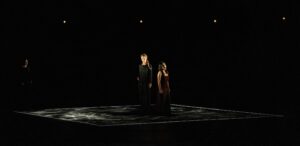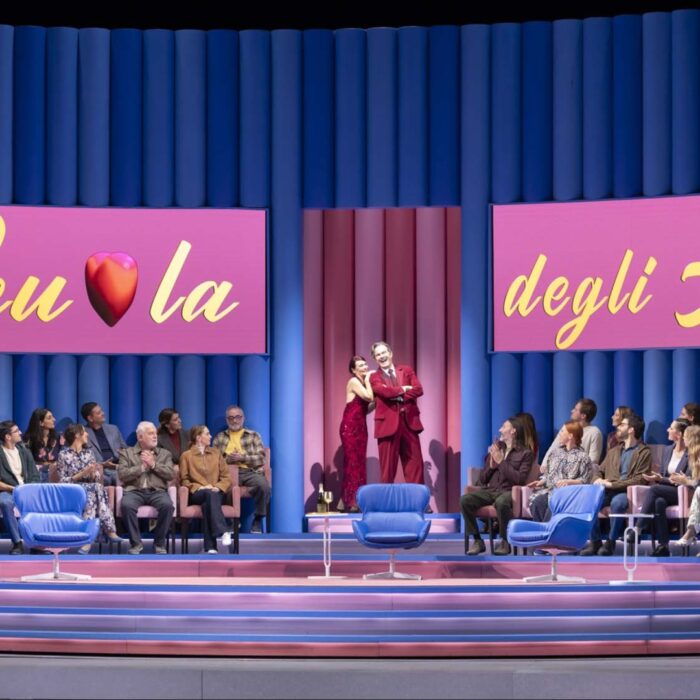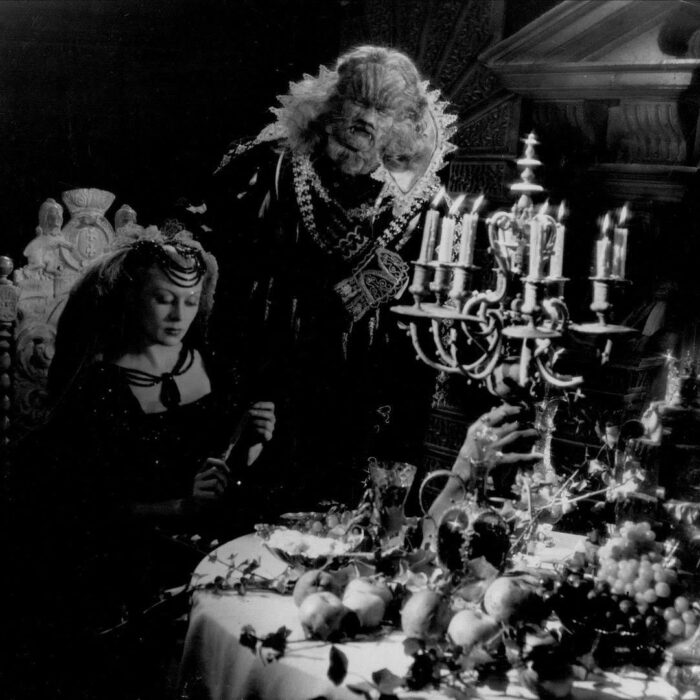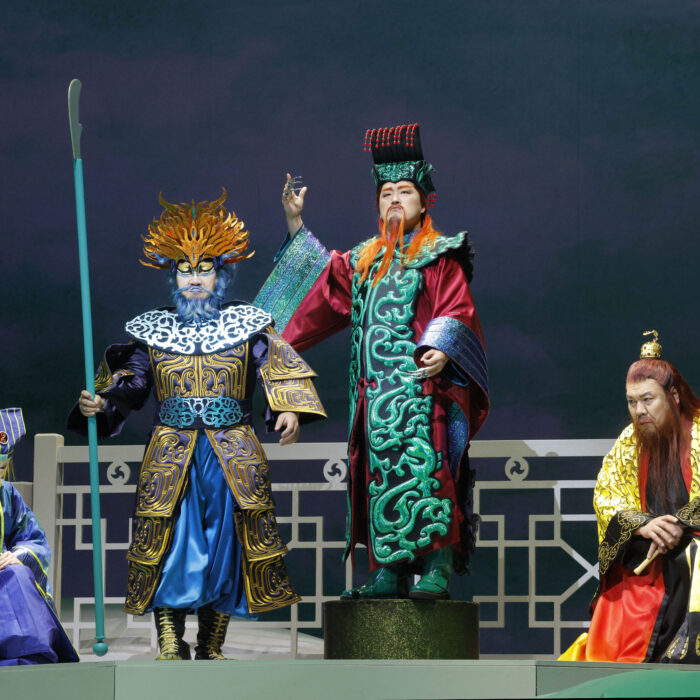
The Haydn Foundation Trento 2023 Review: Hanjo
Hosokawa’s Opera Proves Its Worth In An Intense & Stark Staging
By Alan Neilson(Photo Credit: Francesco Bondi)
The Haydn Foundation, centered in Bolzano, produces classical music concerts and opera for towns and cities across Italy’s Trentino-Alto Adige region. The current season included two performances of Toshio Hosokawa’s 2004 chamber opera “Hanjo” at Trento’s Teatro Sociale.
Hosokawa is a German-trained composer who seeks inspiration for his music in Japan’s cultural heritage, and “Hanjo” is a work very much in this mould. It is a piece that draws together the practices and traditions of Japanese nō theatre with Western theatre to create a fusion.
Nō theater has obvious similarities with opera in that they both use a combination of music, words, costume and dance in their presentation to move the audience; both possess a communicative depth that is not reachable through the words alone. Nō plays, however, are bound by tradition in a way that opera is not. The instruments are fixed, restricted to a bamboo flute, a side drum, a hip drum and an optional large drum, and the players sit in designated positions at the rear of the stage. Scenery is restricted to a tree, while props are few and basic. There is a chorus of about eight people, which does not have a fixed identity and is positioned on one side of the stage. The plays focus on a single emotion that dominates the main character, who usually wears a mask, and role types are more significant than names. Gestures, movement and dance are restrained and abstract.
Form is, therefore, of primary importance in nō theatre, and it is from this that the meaning of the drama is developed, relayed through a series of sights and sounds that, although relating to reality, are fundamentally aimed at communicating with the imagination and encouraging reflection. Hosokawa embraced this underlying philosophy along with many of the practices of nō theatre, but used them with sufficient fluidity so that his opera was not a simple reproduction of a nō play but a work that embraced the traditions of modern western theatre and dropped certain conventions associated with nō theatre: there was no mask and the costumes were fairly simple in design, there was no chorus, there were two main characters, and space was given for the consideration of more than a single emotion.
Written by Yukio Mishima and translated into English by Donald Keene, “Hanjo” is a simple tale of a geisha named Hanako who is waiting for her lover, Yoshio, to return. Every day she goes to the station, hoping to see him arrive, but every day she returns home exhausted and disappointed. Meanwhile, her jealous female companion, Jitsuko, who is desperately in love with Hanako, has been trying to conceal her whereabouts to ensure that she never sees her lost love again. After three years of searching, however, Yoshio finally arrives at Hanako’s door, but she does not recognize him, and so he leaves for good, leaving Hanako and Jitsuko together once more. Their lives resume, with Hanako waiting as before and Jitsuko happy to have Yoshio out of their lives.
The title of the opera refers to the name of an old woman whose fan Hanako carries around with her.
The dominating theme is is one of ‘waiting’ and ‘not waiting.’ As Hanako says to Jitsuko when she is rebuked for always waiting, “not waiting is running away,” which Jitsuko has indeed been doing in trying to hide from Yoshio. However, the theme of jealousy and love also enter into the narrative through Jitsuko’s feelings for Hanako and the fear of losing her.
Veggetti & His Team Serve Up A Stark, Clearly Defined Presentation
The director, Luca Veggetti, along with his team: Clifton Taylor, scenographer and lighting designer; Peter Speliopoulus, costume design; and Moe Yoshida, art work, together created a stark aesthetic. The drama took place on a black, empty stage without any props. A white-colored, chalked, square outline on the floor of the stage, possibly denoting Hanaka’s personal or physical space or even perhaps her apartment, was the area in which the characters mostly interacted with each other. The singers never physically touched each other, and, in line with the traditions of nō theatre, gestures were restrained, although they were more natural and less stylized. A single dancer, Alice Raffaelli, moved deliberately and slowly around the stage, although she never entered the chalk-outlined square. Unlike in nō theatre, however, the costumes were simple and deliberately designed not to interfere with the emotional expression of the singers.
The only set change was the brief introduction of a white screen crossed by black lines, suggestive of Japanese artwork.
The overall effect of the staging allowed the aesthetic, atmospheric and practical aspects to merge into a unified and unobtrusive backdrop that brilliantly supported the drama by allowing the emotions of the characters to emerge in a concentrated form.
With its thin textures and frequent use of drums, Hosokawa’s score was clearly inspired by the music of the nō theatre, but he certainly was not restricted by it. He created a mesmeric soundscape, full of interesting detail and color, in which his use of strings and percussion captured the attention. The music, often unsettled and unsettling, nevertheless drew in the listener with the sliding sounds of the strings, sometimes building to a climax topped by a drum, sometimes dissipating into an anti-climax, while at other times it suddenly changed direction, but it always held the attention, and it did so without upstaging the drama, which it supported splendidly.
The Orchestra Haydn di Bolzano e Trento produced an excellent performance, expertly conducted by Marco Angius.
Emotionally Strong Vocal Portraits
The cast consisted of three singers. All displayed quality, and together they created an intense stage drama in which the expressivity and honesty they brought to their roles were formidable. Their emotions were presented directly, in a raw state, without resorting to superficial tricks and gestures.
We first meet Hanako at the point in which her waiting is no longer a simple yearning for a lost lover and is descending into a mental disturbance where reality, fixation, obsession and delusion have collided. It comes as no surprise when she fails to recognize Yoshio. Her reality had long since taken a different path. Soprano Eri Nakamura was excellent in the role, to which she brought insight and depth. Although it was a very emotional performance, she was careful never to descend into hysterical gesturing or vocal excess. The emotions were largely kept within, which made them appear more powerful. She possesses a versatile, expressive voice with a beautiful timbre, which was most clearly displayed during her meeting with Yoshio, in which her voice received little orchestral support.
Soprano Abigail Fischer gave an impressive performance as Jitsuko Honda, in which she brilliantly captured her character’s anxieties and fears as well as the genuine feelings she has for Hanako. She possesses a distinct, colorful voice with a high degree of versatility, which she employed intelligently to convey her emotions in a very direct, unadorned manner. Her voice also possessed a layered quality that allowed her to furnish the vocal line with subtlety, variety and intensity. This gave added depth to her expressivity. Her singing was always clear, articulate and precise. She was particularly strong in her confrontation with Yoshio, whom she did not want Hanako to see, in which a variety of emotions competed to assert themselves.
Yoshio is a relatively minor role, but baritone Adam Richardson was able to bring him convincingly alive, emphasizing his rational, genuine and fairly restrained emotional nature. His pained reaction to Hanako’s rejection was movingly portrayed and fully believable. It was also a performance that showed off the warm, rounded lyricism of his voice.
Since receiving its premiere in 2004 in Aix-en-Provence, “Hanjo” has had a number of revivals, and it is easy to see why: it is a powerful dramatic work with a fascinating and engaging score that is able to hold the audience’s attention. Moreover, Veggetti’s decision to embrace the work’s connections with nō theatre, something that past directors have not always opted for, was a good decision; it allowed the full extent and depth of the emotions to be examined, undisturbed by a busy staging, and it did so without dulling the drama.



